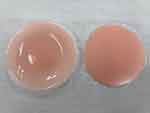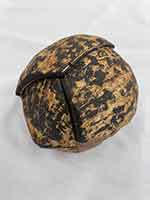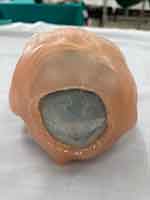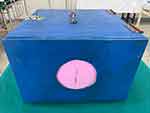Back to Journals » Advances in Medical Education and Practice » Volume 13
Development and Application of “Cervical Dilatation Model for Teaching and Training”
Authors Chooha U , Chotwattanakulchai N , Sirisome J
Received 15 May 2022
Accepted for publication 14 September 2022
Published 23 September 2022 Volume 2022:13 Pages 1123—1131
DOI https://doi.org/10.2147/AMEP.S374832
Checked for plagiarism Yes
Review by Single anonymous peer review
Peer reviewer comments 3
Editor who approved publication: Dr Md Anwarul Azim Majumder
Umasawan Chooha,1 Nadsuda Chotwattanakulchai,2 Jirawun Sirisome1
1Department of Maternal-Newborn Nursing and Midwifery, Faculty of Nursing Rajamangala University of Technology Thanyaburi, Pathum Thani, Thailand; 2Department of Maternal-Newborn Nursing and Midwifery, Srisavarindhira Thai Red Cross Institute of Nursing, Bangkok, Thailand
Correspondence: Umasawan Chooha; Nadsuda Chotwattanakulchai, Email [email protected]; [email protected]
Background: Each year nursing schools pay more for teaching equipment at the nursing laboratory to improve practical skills. The development of the cervical dilatation model for teaching to reduce teaching and training costs is essential. This research aimed at developing a kind of cervical dilatation model for teaching and training.
Methods: Developing a cervical dilatation model for teaching and training with the same structure and operation configuration is like the cervical dilatation model in laboratory practices of nursing. The appearance, structure, and operating accessories were developed from the original. The differences between the original cervical dilatation model and the cervical dilatation model for teaching and training are as follows: the original cervical dilatation model has only vaginal and fetal skulls of various sizes but the cervical dilatation model for teaching and training content follows vaginal, ischial spine, fetal skulls of various sizes, and cervical dilation and effacement. We then compare the teaching effect of the cervical dilatation model for teaching and training with the original cervical dilatation model (including knowledge, vaginal exam scores, and satisfaction after training).
Results: There was no significant difference in the knowledge and vaginal examination scores of the experimental group and control group before training. The vaginal examination scores in the experimental group were higher than those in the control group and scored before, immediately after, and two weeks after the intervention was statistically significantly higher than before training at 0.05 (68.86 ± 3.89, 88.10 ± 2.52, 91.06 ± 1.33) and the trainees had maximum satisfaction in the training.
Conclusion: The cervical dilatation model for teaching and training was highly efficient, and knowledge and practice among nursing students in the intervention group increased after training. The cervical dilatation model for teaching and training could help reduce the cost of teaching equipment, increase teaching and training resources, and improve the trainee’s knowledge and practice skills.
Keywords: development, cervical dilatation model for teaching and training, nursing students
Introduction
The nursing profession is a profession that focuses primarily on the practice of caring for the recipients of the service provider. Therefore, practical teaching is at the heart of the nursing program, where nursing students must apply theoretical knowledge in nursing practices to service recipients. The maternal newborn and midwifery nursing practicum requires both maternal and fetal nursing care, which requires specialized expertise. Students must practice their skills before going to practice with their patients. Therefore, practicing nursing practice skills in all activities of nursing students in nursing laboratories is important before taking up practical training in the clinic.1
The purpose of the maternal newborn and midwifery nursing practicum is the clinical nursing practice by applying holistic nursing care for maternal newborns and midwifery during antepartum, intrapartum, and postpartum phases, and normal newborn care. In the labor room, nursing students must have knowledge of the mechanisms of labor, the cervical dilatation of the uterus is an indication of the progress of labor,2 Therefore, nursing students must understand and have the skills to assess cervical dilatation.
The first stage of labor is considered to last from the onset of regular uterine contractions to full dilation of the cervix, and the first stage of labor is now divided into only two phases: latent and active phases.3–5 During the latent phase, there is more progress in effacement of the cervix and little increase in descent. During the active phase, there is more rapid dilation of the cervix and increased rate of descent of the presenting part. Dilation of the cervix is the enlargement or widening of the cervical opening and the cervical canal that normally occurs once labor has
begun. The diameter of the cervix increases from less than 1 cm to full dilation (approximately 10 cm) to allow birth of a term fetus. Full cervical dilation marks the end of the first stage of labor.2 Maternal physiological changes in the first stage of labor cause pain to suffer for the birther. Midwives should have practical skills to access the physiological changes, as well as be able to assess the enlarged opening of the cervix. In order to be able to provide nursing care in accordance with the changes that have been made appropriately. Therefore, it is important to practice skills in nursing laboratories.
Each year nursing schools pay more for teaching equipment at the nursing laboratory to improve practical skills for the nursing students before clinical internships. The Department of Maternal and Child Nursing needs to purchase many teaching equipment in midwifery laboratories to teach nursing students to prepare for their experience in the clinic, including the vaginal examination model, which is quite expensive. Therefore, the development of the cervical dilatation model for teaching and training to reduce teaching and training costs is essential.
Therefore, this research aims at developing a kind of “cervical dilatation model for teaching and training”, which is low-cost, durable, and can meet the needs of assessing cervical dilatation skills, operation process training, and is easy to manage.
Materials
The device and materials assembled the cervical dilatation model for teaching and training are shown in (Figures 1–4) since the ripe cervix feels soft and silicone-like texture, nipple silicone pads were used to duplicate in the cervical dilatation model for teaching and training (Figure 1). To make the first cervical model: represented 1 cm of cervical dilatation and 50% of cervical effacement, three pads were attached together and were cut in the middle to make a 1 cm circle. For the second cervical model: 3 cm of cervical dilatation and 75% of cervical effacement, two layers of silicone nipple pads were applied. The third cervical model: 5 cm of cervical dilatation and 100% of cervical effacement, a silicone pad was used. The last cervical model: fully cervical dilatation, a coconut skull was implemented as a fetus skull, and a coconut skull was implemented as a fetus skull (Figures 2 and 3).
 |
Figure 1 Nipple silicone pads. |
 |
Figure 2 Coconut skull. |
 |
Figure 3 Show cervical dilatation. |
 |
Figure 4 Cervical dilatation model for teaching and training. |
Participating and Methods
A quasi-experimental study was conducted using an intervention group at the Rajamangala University of Technology Thanyaburi, Pathum Thani, Thailand. The sample size of the study was 60 subjects randomly selected as undergraduate nursing students in the third year, split equally into the intervention and control group (30 persons in each group) by simple randomization, using the table of random numbers and sampling frame (list of nursing students in a classroom).
Teaching Methods
Set up a training assessment team, with members of the research group as team members. The theoretical training contents were lectured first then knowledge of vaginal examination was taken. Researchers and the teaching team were briefed to ensure the homogenization of the training for teachers in the team. the total training time of the class was 1 hour (60 min).
Teaching Methods of the Control Group
The mode of combining theory with practice teaching made PPT on the theoretical content of the vaginal examination according to the requirements of the syllabus. In course of classroom teaching same as every year, the learning purpose, process, and key points of the vaginal examination were explained for about 60 min, and the original cervical dilatation model was used for training by teachers. The original cervical dilatation model was made from rubber. Although they are available in two sizes of cervical dilatation from 1 to 2 centimeters, the whole including cervical dilatation and fetal head made from rubber. The nursing students were divided into a small group (3–4 persons per each group), and the time was 30 min/group. After that, they could repeatedly invite teachers to answer questions, guide, demonstrate, and correct operations according to their own needs. The time was about 30 min. After training in the classroom, the students practiced at clinics for five days per week in the labor room for a total of two weeks under the supervision of a nursing instructor in the mother and child nursing and midwifery departments.
Teaching Methods of the Experimental Group
The experimental group is described like a control group of the learning purpose, process, and key points of the vaginal examination were explained for about 60 min, and the cervical dilatation model which provide 4 means (1cm.50%, 3cm.75%, 5cm.100% and 10 cm 100%) for teaching and training was used for training by teachers. The time was 30 min per group like the control group. After those students practiced the use of the cervical dilatation model for teaching and training in groups and could repeatedly invite teachers to answer questions, guide, demonstrate, and correct operations according to their own needs. The time was about 30 min. After training in the classroom, the students practiced at clinics for five days per week in the labor room for a total of two weeks under the supervision of a nursing instructor in the mother and child nursing and midwifery departments.
Data Collection Tools
The instruments used for data collection were the “knowledge” “practice” and “satisfaction” questionnaires. The knowledge questionnaire was 20 items total of 100 points. The practice questionnaire was 20 items total of 100 points. The satisfaction questionnaire was 20 items which were rated on 5-point Likert scales (1–5 points) with the following ratings: lowest, low, moderate, high and highest. The interpretation of the scores was divided into the following five levels of satisfaction: lowest (1.00–1.50 points); low (1.51–2.50 points); moderate (2.51–3.50 points); high (3.51–4.50 points) and highest (4.51–5.00 points). The instruments were examined by five qualified experts who tested for validity and item-objective congruence (IOC). Validities of knowledge, practice and satisfaction questionnaires were 0.92, 0.88 and 0.94, respectively. The reliabilities of these instruments were tried out with 30 samples by finding Cronbach’s alpha coefficient (α–coefficient), which equaled 0.95 (knowledge questionnaires), 0.92 (practice questionnaire), and 0.97 (satisfaction questionnaires).
Data Analysis
Data were collected before, immediately after, and two weeks after the intervention using knowledge, practice, and satisfaction questionnaires. Data were analyzed using SPSS 22; descriptive statistics t-test was used for the comparison between the group, and analysis of variances with repeated measures was used to analyze the data.
Results
There was no statistically significant difference between the experimental group and control group of nursing students in terms of number and age, see Tables 1 for details.
 |
Table 1 Comparison of Age of Two Groups of Nursing Students |
Comparing knowledge scores in nursing students before training between the experimental group and control group with knowledge questionnaire (total score 100) found that there was no statistically significant difference between the experimental group and control group of nursing students in terms of number and pre-test of knowledge before training (P > 0.05), see Tables 2 for details.
 |
Table 2 Compare Knowledge Scores in Nursing Students Before Training |
Comparing vaginal examination scores in nursing students before training between the experimental group and control group with vaginal examination questionnaire (total score 100) found that there was no statistically significant difference between the experimental group and control group of nursing students in terms of number, and results of the vaginal examination scores before training (P > 0.05), see Tables 3 for details.
 |
Table 3 Compare Vaginal Examination Scores in Nursing Students Before Training |
Compared vaginal examination scores immediately after training of the experimental group of nursing students were higher than those of the control group (P < 0.001), see Table 4 for details.
 |
Table 4 Compare Vaginal Examination Scores in Nursing Students Immediately After Training |
Comparing vaginal examination scores of nursing students before, immediately after, and 2 weeks after training, it was found that immediately after and 2 weeks after training were statistically significantly higher than before training at 0.05, see Table 5 for details.
 |
Table 5 Comparing Vaginal Examination Scores of Nursing Students Before–After Training |
The results of the analysis of satisfaction of the participants in the training in relation to the training activities revealed that the participants had the highest level of satisfaction overall with a mean of 4.81 and 4.66. When individual aspects were considered, the satisfaction was also found to be at the highest level with a mean of 4.93 about Activity media in experimental group. The aspect with the lowest level of satisfaction was “Activity Media” in control group, as shown in Table 6 for details.
 |
Table 6 Satisfaction with Training Activities |
Discussion
The purpose of this study was to develop a kind of “cervical dilatation model for teaching and training.” The results of this study show that after training nursing students with the “cervical dilatation model for teaching and training” and the original cervical dilatation model, the average knowledge scores in nursing students before training of experimental groups and control groups were no different, and after the experimental group was trained with cervical dilatation model for teaching and training, vaginal examination skills of the experimental groups had been improved, which is consistent with the results of similar studies.6,7 This study found that the experimental group had faster learning skills than the control group. After the theoretical explanation, students integrate theoretical cognition and action skill training into the operation process in the simulation practice process, master and use the knowledge learned to obtain skills and experience, thus improving their operation skills and self-confidence.8 A new learner who has no experience in evaluating the dilation of the cervical in a birther needs to practice it skillfully for confidence and to reduce harm to patients.8,9
Students were highly satisfied with the training based on the “cervical dilatation model for teaching and training” It may be that nursing students have put their theoretical knowledge into practice with models to increase confidence. This is actually a combination of theoretical and practical teaching as general teaching in clinical. According to this study, overall satisfaction scores in both groups were the highest. Satisfaction scores in the active media experimental group (cervical dilatation model for teaching and training) had the highest score. In contrast, the active media score control group (original cervical dilatation model) had the lowest score. The experimental group’s highest satisfaction with teaching equipment was due to the fact that they had taken practical action with the cervical dilatation model for teaching and training. Realistic touch with silicone simulated as a soft ripe cervix,2 “cervical dilatation model for teaching and training” helps to solve the problem of cost expensive and insufficient cervical dilatation model equipment, which is consistent with the results of similar studies.6,10 The research team sought to create a low-cost, reproducible, and versatile model that can accurately teach a new learner and learner ability to practice vaginal examination skills. The novelty of this model is its ability to assess cervical dilate 1–10 cm and unripened cervix.
Unfortunately, nursing students would not have real experience in cervical dilatation exams in the laboratory.9 Nursing students must practice their expertise before providing nursing care to the birther to assess the progression of labor.11–13 If nursing students do not have the expertise to conduct assessments, they will misassemble the progress of labor. A cervical exam, in addition to being able to assess the progression of labor, is also possible. Frequent cervical exams may be causing the birther pain and risks.14,15 However, although the birth process is a natural process, there may be risks and complications from the birth process. Therefore, a close assessment of the birther must be carried out.16,17 Vaginal exams are usually performed every 2 to 3 hours unless concerns arise and warrant more frequent exams.18 And to provide better patient outcomes by decreasing the rate of cesarean sections and length of hospital stays for women19 Therefore, nursing students must train in the nursing laboratory before the practice in the clinic was conducted, should practice hands-on with Sim Mom or model first to increase expertise and confidence.10,20
At present, this model has been used by a single, faculty of nursing to teach nursing students, to confirm the validity of this model, and the limitation of this model is that the membranes are not realistic and should be further developed to be used in nursing students in the next generation.
Strengths and Limitations
After the research was finished, researchers encouraged both groups, the experimental and control groups, to examine cervical dilatation from the cervical dilatation model that researchers have developed.
The model construction is very durable; therefore, it would be used in many years. Furthermore, the hardness of coconut skull is similar to that of fetal skull. The softness of silicone nipple pads is able to represent ripe cervix, and therefore, the practice of vaginal examination from these models gives good simulation experience to nursing students. Also, silicone nipple pads are affordable, reachable, and easy to change in case of being ruined. However, the special cervical dilatation models were developed just 4 dilatations: 1 cm, 3 cm, 5 cm and 10 cm. Nursing student should have the opportunity to practice cervical dilatation from 1 to 10 cm. Therefore, further research should develop 10 cervical dilatation models.
Conclusion
The cervical dilatation model for teaching and training can save the purchase cost of teaching equipment, increase teaching and training resources, and improve the trainee’s knowledge, practice skills and make users satisfied because the cervical dilatation model for teaching and training is virtual. The school of nursing and medical colleges can use them to train students very well to prepare students before practicing in the clinic.
Ethical Approval and Consent to Participate
All the participants voluntarily participated in this study and provided written informed consent. The Ethics Committee of the Rajamangala University of Technology Thanyaburi approved this study Project Code: RMUTT_REC No. Exp 16/64 on 16 June 2021. We confirm that all methods were carried out in accordance with the guidelines and regulations of the Biomedical Research Ethics Committee at the Rajamangala University of Technology Thanyaburi.
Acknowledgment
The author would like to thank the research and development institute of Rajamangala University of Technology Thanyaburi, for approving the ethics for research involving human subjects for this study. The author would also like to express her appreciation to Assoc. Prof. Poonsuk Hingkanon, Dean of the Faculty of Nursing, Rajamangala University of Technology Thanyaburi, who helped and promoted the research. Lastly, the author would like to thank everyone on the research team who helped conduct the research to its successful completion, and each of the experts who provided suggestions and offered guidelines for conducting this study until its successful completion.
Disclosure
The authors report no conflicts of interest in relation to this work.
References
1. Morgan R. Using clinical skills laboratories to promote theory-practice integration during first practice placement: an Irish perspective. J Clin Nurs. 2006;15(2):155–161. doi:10.1111/j.1365-2702.2006.01237.x
2. Lowdermilk LD, Perry ES, Cashion K, Alden RK, Olshansky E. Maternity Woman’s Health Care.
3. Cunningham F, Leveno K, Bloom S, et al. Williams Obstetrics.
4. ACOG. ACOG committee opinion no. 766: approaches to limit intervention during labor and birth. Obstet Gynecol. 2019;133(2):e164–e173. doi:10.1097/AOG.0000000000003074
5. World Health Organization. WHO recommendations: intrapartum care for a positive childbirth experience; 2018. Available from: https://apps.who.int/iris/bitstream/handle/10665/260178/9789241550215-eng.pdf.
6. Perry JD, Maples JM, Deisher HN, et al. A novel approach to teaching the cervical exam: a versatile, low-cost simulation for labor and delivery learners. Cureus. 2021;13(12):e20235. doi:10.7759/cureus.20235
7. Yimyam S, Sansiriphun N, Chaloumsuk N. Developing a vaginal exam simulation box for labor progression assessment training. Nurs J CMU. 2018;45(3):83–96.
8. Kainer F. Simulation–based training in obstetrics. Arch Gynecol Obstet. 2014;289:703–704. doi:10.1007/s00404-014-3151-6
9. Nitsche JF, Shumard KM, Fino NF, et al. Effectiveness of labor cervical examination simulation in medical student education. Obstet Gynecol. 2015;126(Suppl 4):13S–20S. doi:10.1097/AOG.0000000000001027
10. Shea KL, Rovera E. Vaginal examination simulation using citrus fruit to simulate cervical dilation and effacement. Cureus. 2015;7(9):e314. doi:10.7759/cureus.314
11. Dalal AR, Purandare AC. The partograph in childbirth: an absolute essentiality or a mere exercise? J Obstet Gynaecol India. 2018;68(1):3–14. doi:10.1007/s13224-017-1051-y
12. Hutchison J, Mahdy H, Hutchison J. Stages of Labor. In: StatPearls. Treasure Island (FL): StatPearls Publishing; 2022. Available from. https://pubmed.ncbi.nlm.nih.gov/31335010/.
13. Zhang J, Troendle J, Mikolajczyk R, et al. The natural history of the normal first stage of labor. Obstet Gynecol. 2010;115(4):705–710. doi:10.1097/AOG.0b013e3181d55925
14. Liao JB, Buhimschi CS, Norwitz ER. Normal labor: mechanism and duration. Obstet Gynecol Clin North Am. 2005;32(2):145–164. doi:10.1016/j.ogc.2005.01.001
15. Gluck O, Mizrachi Y, Ganer Herman H, et al. The correlation between the number of vaginal examinations during active labor and febrile morbidity, a retrospective cohort study. BMC Pregnancy Childbirth. 2020;20(1):246. doi:10.1186/s12884-020-02925-9
16. Zhang J, Landy HJ, Ware Branch D, et al. Consortium on safe labor. Contemporary patterns of spontaneous labor with normal neonatal outcomes. Obstet Gynecol. 2010;116(6):1281–1287. doi:10.1097/AOG.0b013e3181fdef6e
17. Kilpatrick SJ, Laros RK. Characteristics of normal labor. Obstet Gynecol. 1989;74(1):85–87.
18. ACOG. ACOG committee opinion no. 766 summary: approaches to limit intervention during labor and birth. Obstet Gynecol. 2019;133(2):406–408. doi:10.1097/AOG.0000000000003081
19. Harris SJ, Janssen PA, Saxell L, et al. Effect of a collaborative interdisciplinary maternity care program on perinatal outcomes. CMAJ. 2012;184(17):1885–1892. doi:10.1503/cmaj.111753
20. Pratinidhi A, Patange R, Patil S, et al. Testing of simulation training device for assessment of cervical dilatation among nursing student of Karad, India. Health Sci J. 2014;8(4):495–501.
 © 2022 The Author(s). This work is published and licensed by Dove Medical Press Limited. The full terms of this license are available at https://www.dovepress.com/terms.php and incorporate the Creative Commons Attribution - Non Commercial (unported, v3.0) License.
By accessing the work you hereby accept the Terms. Non-commercial uses of the work are permitted without any further permission from Dove Medical Press Limited, provided the work is properly attributed. For permission for commercial use of this work, please see paragraphs 4.2 and 5 of our Terms.
© 2022 The Author(s). This work is published and licensed by Dove Medical Press Limited. The full terms of this license are available at https://www.dovepress.com/terms.php and incorporate the Creative Commons Attribution - Non Commercial (unported, v3.0) License.
By accessing the work you hereby accept the Terms. Non-commercial uses of the work are permitted without any further permission from Dove Medical Press Limited, provided the work is properly attributed. For permission for commercial use of this work, please see paragraphs 4.2 and 5 of our Terms.
